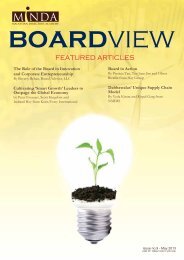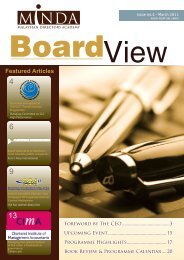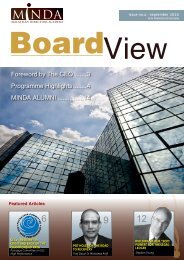September 2011 - MINDA Malaysian Directors Academy ...
September 2011 - MINDA Malaysian Directors Academy ...
September 2011 - MINDA Malaysian Directors Academy ...
You also want an ePaper? Increase the reach of your titles
YUMPU automatically turns print PDFs into web optimized ePapers that Google loves.
article fourFigure 3 shows those elements of governance that matter iflong-term value is to be created. The company must:1. Look at its business purpose through a moral filter toensure that it is not doing things that are wrong;2. Evaluate the risk-reward trade-off implied by its riskappetite and the expected rewards it will receive fordoing the business to ensure that it is worth takingthese risks;3. Decide the basis of governance it will adopt to ensurethat the “Tone at the Top” is correct and there areappropriate processes and procedures in place toensure the company adheres to its Mission, Vision andValues. Depending on its level of sophistication and thematurity of its people, the company can choose a rulesbasedor a principles-based approach to governance.The key to good governance is the need for balance betweenhaving processes and procedures which are essential,while allowing enough flexibility for experimentation andtolerance of error essential to innovation. If the companyfocuses totally on rigid procedures and disciplines, there canbe no tolerance of the error that is such an important partof the learning and experimentation that are the foundationof innovation and there can be no flexibility in approachingproblems in ways not set out in the rule book. Equally, ifthere are no processes and procedures and everything isdone ‘by the seat of the pants’, there will be failures ofgovernance leading to fraud and worse. A sensible, balancedapproach to corporate governance should make clear toall in the organisation what its Mission, Vision and Valuesare, emphasising the principles underlying the desiredand expected behaviours and making it quite clear whichbehaviours will be rewarded and which will be punished.The resulting code of conduct should be able to reconcilethe need to create conditions favourable to innovation withthe need for systems and due process.ConclusionCompanies that survive and prosper in the long run are ableto innovate because they recognise the conditions neededto embrace change.They build into their Vision and Valuesfour key ideas:1. It is OK to fail - provided people learn from theirmistakes and the mistakes do not destroy the company;2. They encourage diversity of thinking and unorthodoxapproaches;3. They look for continuous improvement in their productsand processes;4. They value curiosity and the ability to “connect thedots”.Last of all, they underpin these ideas with a sensiblecorporate governance framework that guides people,rewarding desired behaviours and punishing bad practices.JOHN ZINKINMANAGING DIRECTOR, CORPORATE GOVERNANACEICLIF LEADERSHIP CENTREBefore joining ICLIF, John was the CEO of the SecuritiesIndustry Development Corporation (SIDC). John was alsoChairman of the UMSC Audit Committee until the end of2009. Before joining SIDC John was Associate Professorof Marketing and Strategy at Nottingham UniversityBusiness School, Malaysia Campus and director of the MBAprogramme with responsibility for external affairs. One ofthe founders of the Institute of Corporate ResponsibilityMalaysia (ICRM), he is Deputy Chairman, and is nowan Exco member and the Vice President, Sustainabilityand Governance of the Business Council for SustainableDevelopment Malaysia (BCSDM).17BOARD VIEW_SEPTEMBER <strong>2011</strong>iGroves, A, (1996), Only the Paranoid Survive: How to Exploit the Crisis Points That Challenge Every Company, (Currency Doubleday, NewYork)iiLevitt, T.C. (1960), “Marketing Myopia”, Harvard Business Review, July-August 1960. Levitt defined Marketing Myopia as a short-sightedfocus on the company’s needs rather than understanding what its customers need and want. By omitting to ask the vital question “Whatbusiness are we really in?” companies fail to foresee and adjust to changes in their markets brought about by innovation. An example ofsuch short-sightedness would be of the transatlantic luxury liner companies competing with each on the time taken to go from Europeto the US without realising they were creating a market for the aeroplane by emphasising the importance of speed – something aircraftcould deliver much better than ships, putting them out of business once transatlantic flight became viable.







